
Weight loss is often difficult to achieve, but there is one thing that will assist with achieving your goals. All the calorie counting, diet recipes, and portion control will be of no use if your diet isn’t high in Fibre!
Fibre is a carbohydrate found in plant foods such as fruits, vegetables, and whole grains. Fibre differs from most carbohydrates in a sense that is isn’t easily digested. It passes through the body quite quickly and does not cause your blood sugar levels to rise.
Recent research in the Journal of Nutrition suggests eating more fibre as a way to prevent weight gain or even encourage weight loss. (1). Over the course of the two-year study, the researchers found that boosting fibre by 8 grams for every 1,000 calories resulted in about 4½ pounds of weight lost.
If you wanted to try this for yourself, the simple formula would be to: increase your fibre by 16 grams if you were consuming a 2000 calorie diet.
The recommended daily intake of fibre for women under 50 years old is 25 grams of fiber a day. For men this increases to 38 grams.
Fibre has no fat-burning properties. It is not a magic cure. What fibre does is helps you feel full when in fact you may not be. It is also effective in the way that it adds very few additional calories to your diet.
Fibre helps reduce hunger by filling your stomach, stimulating receptors that send a signal to your brain saying it is time to stop eating.
When having a high fibre diet, you may also want to drink more water. Have at least the recommended amount of water (8 glasses) to assist in helping the fibre move through your digestive system. Water also contributes to a feeling of fullness. Some times when you feel hungry, you are in fact dehydrates. For this reason you must keep hydrated at all times to help prevent snacking and consumption of excess calories.
Soluble fibre, which absorbs water, forms a kind of gel inside your gut. This assists in slowing the absorption of sugars into your bloodstream. As we know, lower blood sugar levels mean lower insulin levels. This has the roll on effect of your body being less likely to store fat.
Ensure you are getting your fibre requirements from food rather than supplementations. A list of high fibre foods follows:
Flaxseeds
2.8 grams per tablespoon
A tablespoon of seeds has nearly three grams of fibre and only 55 calories. Flaxseeds are the richest plant source of omega-3 fats, which help reduce inflammation, ward off mood swings and help prevent heart disease and diabetes.
Almonds
3.6 grams per 30 nuts
30 nuts contains 15 percent of your daily fibre needs. Almonds are a good source of magnesium and iron. Use almonds as a snack to assist in reducing your hunger.
Blackberries
7.6 grams per cup
Blackberries are full of antioxidants that can assist in fighting diseases. Blackberries have more fibre than most other fruits. One cup of blackberries contains fifty percent of the day’s vitamin C.
Raw Avocado
9.8 grams per cup, sliced
Avocados contain more potassium than a banana. Avocado is also full of healthy monounsaturated fats.
Apples
4 grams per apple
A medium apple 7cm in diameter contains 4 grams of fibre. A large apple 9cm has 5. Apples also offer a bit of vitamin C and potassium.
Sweet Potatoes
5 grams per medium potato
A medium-size baked sweet potato (5cm wide, 13cm long), skin included, has 5 grams of fibre and only 103 calories. It’s also extremely high in other nutrients including: 438% daily requirements of vitamin A, 37% daily requirements of vitamin C, plus some potassium, vitamin E, iron, and magnesium.
Raspberries
8 grams per cup
One cup of raspberries has 8 grams of fibre. Raspberries are also an excellent source of vitamin C.
Strawberries
3 grams per cup
One cup of strawberries contains 3 grams of fibre. It will also contain more than the recommended daily requirements of vitamin C.
Chickpeas
8 grams per ¾ cup
3/4 cup of chickpeas has 8 grams of fibre. Chickpeas also contain vitamin B6 and folate.
Pumpkin
3 grams per cup
A cup of cooked pumpkin contains 3 grams of fibre. It also contains vitamin A, vitamin C, vitamin E and potassium.
REFERENCES
-
Journal of Nutrition “fibre as a way to prevent weight gain or even encourage weight loss”.



